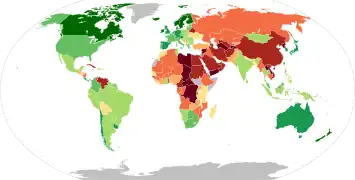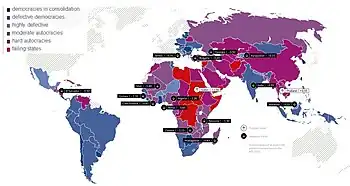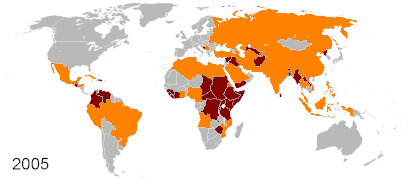Democracy indices
Democracy indices are quantitative and comparative assessments of the state of democracy[1] for different countries according to various definitions of democracy.[2]
| Part of the Politics series |
| Democracy |
|---|
|
|
The democracies indices differ in whether they are categorical, such as classifying countries into democracies, hybrid regimes, and autocracies,[3][4] or continuous values.[5] The qualitative nature of democracy indices enables data analytical approaches for studying causal mechanisms of regime transformation processes.
Democracy indices differ in scope and weighting of different aspects of democracy, including the breadth of core democratic institutions, competitiveness and inclusiveness of polyarchy, freedom of expression, various aspects of governance, democratic norm transgressions, co-option of opposition, electoral system manipulation, electoral fraud, and popular support of anti-democratic alternatives.[6][7][8]
Prominent democracy indices
Operating
- Bertelsmann Transformation Index by the Bertelsmann Stiftung, evaluations by country, regional, and general experts, some evaluations by representative surveys of regular citizens. Spectrum: then averaging of scores for: hard-line autocracy, moderate autocracy, very defective democracy, defective democracy, consolidating democracy.[9]
- The Economist Democracy Index, by the UK-based Economist Intelligence Unit, is an assessment of countries' democracy. Countries are rated as full democracies, flawed democracies, hybrid regimes, or authoritarian regimes. The index is based on five different categories measuring pluralism, civil liberties, and political culture.[10]
- Freedom in the World, is a yearly survey and report by the U.S.-based[11] non-governmental organization Freedom House that measures the degree of civil liberties and political rights in every nation and significant related and disputed territories around the world.[12]
- The Global State of Democracy Indices by International Institute for Democracy and Electoral Assistance assesses democratic performance using different types of sources: expert surveys, standards-based coding by research groups and analysts, observational data and composite measures.[13]
- V-Dem Democracy indices by V-Dem Institute distinguishes between five high-level principles of democracy: electoral, liberal, participatory, deliberative, and egalitarian, and quantifies these principles.[14] The V-Dem Democracy indices include the Citizen-initiated component of direct popular vote index, which indicates the strength of direct democracy and the presidentialism index, which indicates higher concentration of political power in the hands of one individual.
Indices measuring aspects of democracy
- Effective number of parties is an index of the adjusted number of political parties in a country's party system.[15]
- Fragile States Index, formerly the Failed States Index, is an annual report that aims to assess states' vulnerability to conflict or collapse, ranking all sovereign states with membership in the United Nations where there is enough data available for analysis.[16]
- Gallagher index measures an electoral system's relative disproportionality between votes received and seats in a legislature.[17]
Other measured aspects of democracy include voter turnout and political efficacy.[18][19]
Historical
- Democracy-Dictatorship Index is a binary measure of democracy and dictatorship.[20]
- Democracy Ranking is a democracy ranking by the Association for Development and Advancement of the Democracy Award.[21]
- Polity data series contains annual information on regime authority characteristics and covers the years 1800–2018 based on competitiveness, openness, and level of participation, sponsored by the Political Instability Task Force (PITF).[22]
- Boix-Miller-Rosato dichotomous coding of democracy, easy-to-observe characteristics, few evaluations by own researchers based on academic literature. As a classification: non-democracy to democracy.[23]
- Lexical Index of Electoral Democracy (LIED) by Skaaning et al. democracy's characteristics assessed with easy-to-observe characteristics, few evaluations by own researchers based on academic research. Then evaluating whether necessary characteristics are present or not.[24]
- The Index of Democratization created by Tatu Vanhanen
Maps of indices
 Country ratings from Freedom House's Freedom in the World 2021 survey
Country ratings from Freedom House's Freedom in the World 2021 survey Democracy Index map in 2020 according to The Economist Intelligence Unit
Democracy Index map in 2020 according to The Economist Intelligence Unit Global trend report analyzes the results of the Bertelsmann Transformation Index 2022 [25]
Global trend report analyzes the results of the Bertelsmann Transformation Index 2022 [25] Democracy-Dictatorship Indexs in 2008.[26]
Democracy-Dictatorship Indexs in 2008.[26] Fragile States Index 2005–2013'
Fragile States Index 2005–2013'
Difficulties in measuring democracy
Because democracy is an overarching concept that includes the functioning of diverse institutions which are not easy to measure, limitations exist in quantifying and econometrically measuring the potential effects of democracy or its relationship with other phenomena—whether inequality, poverty, education etc.[27] Given the constraints in acquiring reliable data with within-country variations on aspects of democracy, academics have largely studied cross-country variations, yet variations in democratic institutions can be large within countries. Another way of conceiving the difficulties in measuring democracy is through the debate between minimalist versus maximalist definitions of democracy. A minimalist conception of democracy defines democracy by primarily considering the essence of democracy; such as electoral procedures.[28] A maximalist definition of democracy can include outcomes, such as economic or administrative efficiency, into measures of democracy.[29] Some aspects of democracy, such as responsiveness[30] or accountability, are generally not included in democracy indices due to the difficulty measuring these aspects. Other aspects, such as judicial independence or quality of the electoral system, are included in some democracy indices but not in others.
Some measures of democracy, notably Freedom House and Polity IV, deploy a maximalist understanding of democracy by analyzing indicators that go beyond electoral procedure.[31] These measures attempt to gauge contestation and inclusion; two features Robert Dahl argued are essential in democracies that successfully promote accountable governments.[32][33] The democratic rating given by these mainstream measures can vary greatly depending on the indicators and evidence they deploy.[34] The definition of democracy utilized by these measures is important because of the discouraging and alienating power such ratings can have, particularly when determined by indicators which are biased toward Western democracies.[35]
Dieter Fuchs and Edeltraud Roller suggest that, in order to truly measure the quality of democracy, objective measurements need to be complemented by "subjective measurements based on the perspective of citizens".[36] Similarly, Quinton Mayne and Brigitte Geißel also defend that the quality of democracy does not depend exclusively on the performance of institutions, but also on the citizens' own dispositions and commitment.[37]
Critiques of measures of democracy
Data on democracy, and particularly global indices of democracy, have been scrutinized and criticized by various scholars. Gerardo L. Munck and Jay Verkuilen questioned various aspects of the data produced by Freedom House and Polity, such as the concept of democracy they measured, the design of indicators, and the aggregation rule.[38] Political scientists Andrew T. Little and Anne Meng argued that the data produced by Freedom House and the Varieties of Democracy (V-Dem) project relies heavily on subjective, as opposed to objective, measures and thus was tained by coder bias.[39]
See also
References
- Geissel, Brigitte; Kneuer, Marianne; Lauth, Hans-Joachim (2016). "Measuring the quality of democracy: Introduction". International Political Science Review. Sage Publications. 37 (5): 571–579. doi:10.1177/0192512116669141. ISSN 0192-5121. JSTOR 26556872. S2CID 151808737. Retrieved 2023-04-03.
- Greenwood, Shannon (2022-12-06). "Appendix A: Classifying democracies". Pew Research Center's Global Attitudes Project. Retrieved 2022-12-27.
- Dobratz, B.A. (2015). Power, Politics, and Society: An Introduction to Political Sociology. Taylor & Francis. p. 47. ISBN 978-1-317-34529-9. Retrieved Apr 30, 2023.
- Michie, J. (2014). Reader's Guide to the Social Sciences. Taylor & Francis. pp. 95–97. ISBN 978-1-135-93226-8. Retrieved 2023-04-03.
- "Democracy data: how do researchers measure democracy?". Our World in Data. Jun 17, 2022. Retrieved Apr 17, 2023.
- "The 'Varieties of Democracy' data: how do researchers measure democracy?". Our World in Data. 2022-11-30. Retrieved 2023-04-03.
- "Breaking Down Democracy". Freedom House. Retrieved 2023-04-03.
- Democracy and Autocracy, Why do Democracies Develop and Decline, Vol. 21(1) June 2023, Democracy and Autocracy Section, American Political Science Association
- "Governance Report". BTI 2022. Retrieved Apr 17, 2023.
- "Democracy Index 2021: the China challenge". Economist Intelligence Unit.
- William Ide (11 January 2000). "Freedom House Report: Asia Sees Some Significant Progress". Voice of America. Archived from the original on 4 December 2013. Retrieved October 13, 2012.
- "Freedom in the World". Freedom House. 2021-02-01. Retrieved 2023-04-03.
- "The Global State of Democracy Indices". International Institute for Democracy and Electoral Assistance. Retrieved May 26, 2023.
- "Democracy Report 2022: Autocratization Changing Nature?" (PDF), V-Dem Institute, University of Gothenburg
- Laakso, Markku; Taagepera, Rein (1979). ""Effective" Number of Parties: A Measure with Application to West Europe". Comparative Political Studies. 12 (1): 3–27. doi:10.1177/001041407901200101. ISSN 0010-4140. S2CID 143250203.
- "Failed States FAQ". the Fund for Peace. Retrieved 2007-08-25.
- "The Gallagher Index – iscanadafair.ca". iscanadafair.ca. Retrieved Apr 3, 2023.
- Karp, Jeffrey A.; Banducci, Susan A. (2008). "Political Efficacy and Participation in Twenty-Seven Democracies: How Electoral Systems Shape Political Behaviour". British Journal of Political Science. Cambridge University Press. 38 (2): 311–334. ISSN 0007-1234. JSTOR 27568347. Retrieved 2023-06-16.
- "Internal and external political efficacy - Government at a Glance 2021". OECD iLibrary. Retrieved 2023-06-16.
- "Democracy-Dictatorship_Index". Kaggle. Jul 17, 2020. Retrieved Apr 3, 2023.
- "Home". Democracy Ranking (in German). Feb 12, 2017. Retrieved Apr 3, 2023.
- "Polity IV Project". Table footnote. Archived from the original on 4 May 2020. Retrieved 11 Jan 2020.
- "Boix-Miller-Rosato dichotomous coding of democracy, 1800-2020, version 4.0 - bmr". xmarquez.github.io. Retrieved Apr 17, 2023.
- Skaaning, Svend-Erik; Gerring, John; Bartusevičius, Henrikas (Apr 26, 2015). "A Lexical Index of Electoral Democracy" (PDF). Comparative Political Studies. SAGE Publications. 48 (12): 1491–1525. doi:10.1177/0010414015581050. ISSN 0010-4140. S2CID 16062427.
- "Global Dashboard". BTI 2022. Retrieved Apr 17, 2023.
- Cheibub, José Antonio; Gandhi, Jennifer; Vreeland, James Raymond (April 2010). "Democracy and dictatorship revisited". Public Choice. 143 (1–2): 67–101. doi:10.1007/s11127-009-9491-2. JSTOR 40661005. S2CID 45234838.
- Krauss, Alexander (January 2, 2016). "The scientific limits of understanding the (potential) relationship between complex social phenomena: the case of democracy and inequality". Journal of Economic Methodology. 23 (1): 97–109. doi:10.1080/1350178X.2015.1069372 – via CrossRef.
- Dahl, Robert A., Ian Shapiro, José Antônio Cheibub, and Adam Przeworski. “Minimalist Conception of Democracy: A Defense.” Essay. In The Democracy Sourcebook, 12–17. Cambridge, MA, MA: MIT Press, 2003.
- Schmitter, Philippe C. and Terry Lynn Karl. 1991. "What Democracy is.. . and is Not." Journal of Democracy 2 (3): 75-88
- Esaiasson, Peter, and Christopher Wlezien. "Advances in the study of democratic responsiveness: An introduction." Comparative political studies 50.6 (2017): 699-710.
- Coppedge, Michael, Angel Alvarez, and Claudia Maldonado. 2008. "Two Persistent Dimensions of Democracy: Contestation and Inclusiveness." The Journal of Politics70 (3): 632-647.
- Samuels, David. “Chapter 3: Democratic Political Regimes.” Essay. In Comparative Politics. New York: Pearson Education, 2013.
- Clark, William Roberts, Matt Golder, and Sona Nadenichek Golder. “Chapter 5: Economic Determinates of Democracy.” Chapter. In Foundations of Comparative Politics, 351–92.
- Högström, John. “Does the Choice of Democracy Measure Matter? Comparisons between the Two Leading Democracy Indices, Freedom House and Polity IV.” Government and Opposition 48, no. 2 (2013): 201–21. doi:10.1017/gov.2012.10.
- Piironen, Ossi. 2005. "Minimalist Democracy without Substance? an Evaluation of the Mainstream Measures of Democracy." Politiikka 47 (3): 189-204.
- Fuchs, Dieter; Roller, Edeltraud (2018). "Conceptualizing and Measuring the Quality of Democracy: The Citizens' Perspective". Politics and Governance. 6 (1): 22. doi:10.17645/pag.v6i1.1188.
- Mayne, Quinton; Geißel, Brigitte (2018). "Don't Good Democracies Need "Good" Citizens? Citizen Dispositions and the Study of Democratic Quality". Politics and Governance. 6 (1): 33. doi:10.17645/pag.v6i1.1216.
- Gerardo L. Munck and Jay Verkuilen, “Conceptualizing and Measuring Democracy: Evaluating Alternative Indices,” Comparative Political Studies 35, 1 (2002): 5-34. https://citeseerx.ist.psu.edu/viewdoc/download?doi=10.1.1.469.3177&rep=rep1&type=pdf
- Andrew Little and Anne Meng,“Measuring Democratic Backsliding.“ PS: Political Science & Politics (forthcoming). https://osf.io/n32zk/
Further reading
- Munck, G.L. (2009). Measuring Democracy: A Bridge between Scholarship and Politics. Democratic Transition and Consolidation. Johns Hopkins University Press. ISBN 978-0-8018-9650-7.
- Kahn, H. (2017). On Measuring Democracy: Its Consequences and Concomitants: Conference Papers. Taylor & Francis. ISBN 978-1-351-50205-4.
- Coppedge, Michael; Gerring, John; Altman, David; Bernhard, Michael; Fish, Steven; Hicken, Allen; Kroenig, Matthew; Lindberg, Staffan I.; McMann, Kelly; Paxton, Pamela; Semetko, Holli A.; Skaaning, Svend-Erik; Staton, Jeffrey; Teorell, Jan (2011). "Conceptualizing and Measuring Democracy: A New Approach". Perspectives on Politics. [American Political Science Association, Cambridge University Press]. 9 (2): 247–267. doi:10.1017/S1537592711000880. ISSN 1537-5927. JSTOR 41479651. S2CID 11629045.
- Croissant, Aurel; Pelke, Lars (2022-04-25). "Measuring Policy Performance, Democracy, and Governance Capacities: A conceptual and methodological assessment of the Sustainable Governance Indicators (SGI)". European Policy Analysis. Wiley. 8 (2): 136–159. doi:10.1002/epa2.1141. ISSN 2380-6567.
- Sönmez, Hakan (2020-09-30). "Democratic Backsliding or Stabilization?". Politikon: The IAPSS Journal of Political Science. International Association for Political Science Students. 46: 54–78. doi:10.22151/politikon.46.3. ISSN 2414-6633. S2CID 224846248.